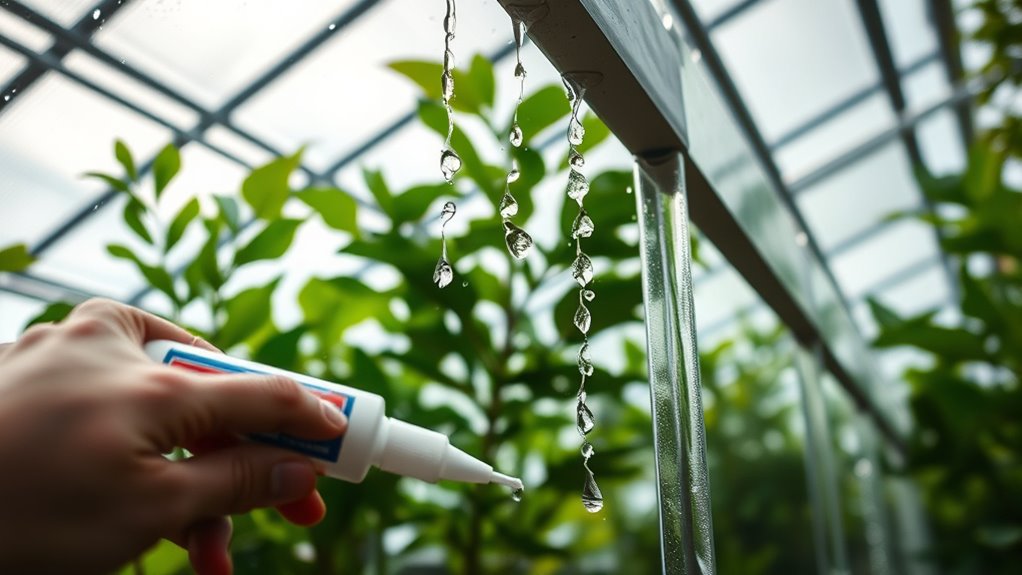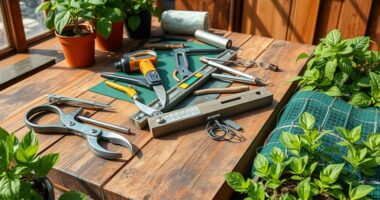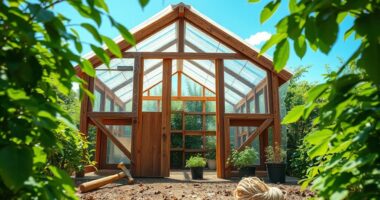To waterproof your greenhouse, start by understanding different sealing methods for materials like glass or polycarbonate. Choose UV-resistant sealants, such as silicone or polyurethane, for better durability. Make sure to clean and dry surfaces thoroughly before applying the sealant. Regularly inspect for leaks and address any issues promptly. Implementing effective water diversion systems can also help protect your structure. With these tips, you’ll create a thriving environment for your plants – and there’s much more to explore!
Key Takeaways
- Inspect the greenhouse frame for structural integrity and clean all surfaces thoroughly before applying sealants.
- Use UV-resistant sealants like silicone or polyurethane for long-lasting waterproofing.
- Measure and fit panels accurately to prevent gaps that allow water entry.
- Regularly check for leaks around roof vents and joints, addressing any issues promptly.
- Maintain drainage systems to prevent blockages and apply protective coatings to metal parts against rust.
Understanding Greenhouse Sealing Methods
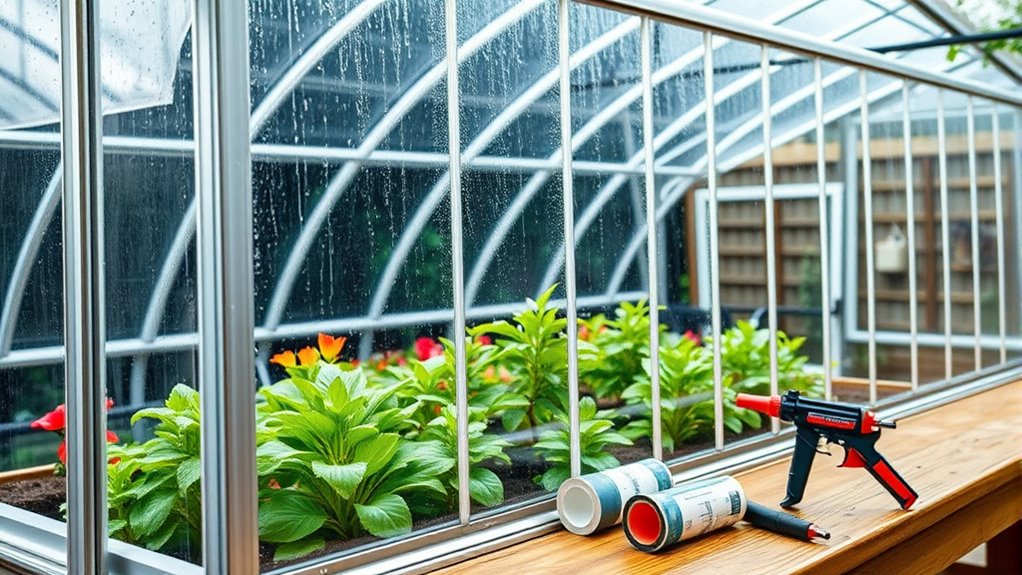
When you seal your greenhouse effectively, you not only prevent air leaks but also maintain an ideal environment for your plants. Proper sealing is essential, as it helps regulate temperature, protects against drafts, and keeps pests at bay.
Different materials, like polycarbonate or glass, require specific sealing techniques to guarantee a weather-tight fit. You can use methods such as tapes, caulking, and spray foam to achieve this.
Also, don’t forget about ventilation; it’s critical for preventing overheating and guaranteeing plant health. By sealing your greenhouse properly, you enhance its durability and lower maintenance costs in the long run.
Tackling common challenges, like air leaks and water entry, will keep your greenhouse functioning at its best.
Choosing the Right Sealants
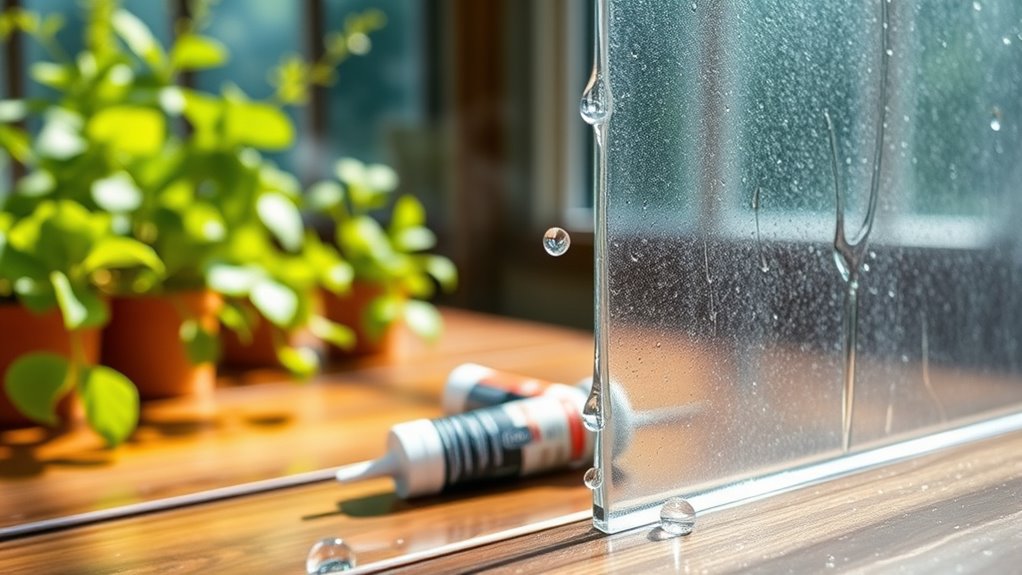
When choosing the right sealants for your greenhouse, you’ll want to contemplate the various types available and their specific applications.
Selecting UV-resistant materials is essential to protect against sunlight damage, ensuring your seals last longer.
Proper application techniques will also help you achieve an effective and lasting waterproof barrier.
Types of Sealants Available
Choosing the right sealant for your greenhouse is essential for ensuring its longevity and efficiency.
You’ll find several options tailored to your specific needs. Silicone sealants are flexible and UV-resistant, perfect for sealing precise gaps and roof vents.
If you’re dealing with high-traffic areas, polyurethane sealants offer superior adhesion and durability. For less demanding applications, acrylic sealants can suffice, though they may not be as robust.
Metal tape is ideal for polycarbonate panels, while edge sealing tape effectively seals flutes in multi-wall polycarbonate structures.
Always consider the surface type, UV stability, and local weather conditions when selecting your sealant to guarantee peak performance and protection for your greenhouse.
Application Techniques for Sealants
How can you guarantee a flawless seal in your greenhouse? Start by choosing the right sealant and applying it correctly. Use a caulking gun for even distribution and track your application.
Here are some essential techniques to keep in mind:
- Clean and dry surfaces to guarantee proper adhesion.
- Cut the tube tip at a 45-degree angle for the right gap size.
- Smooth the sealant with a damp finger to eliminate air pockets.
- Apply evenly to avoid weak spots and guarantee durability.
Don’t forget to check the weather before application—ideal conditions lead to better results.
Once applied, let the sealant cure as per the manufacturer’s instructions for maximal performance.
Selecting UV-Resistant Materials
While selecting UV-resistant materials for your greenhouse, it’s vital to prioritize options that offer both durability and optimal light transmission.
Polycarbonate panels are an excellent choice, known for their strength and superior light diffusion. Acrylic panels provide high clarity and impact resistance, making them perfect for ideal plant growth. If you’re looking for a cost-effective solution, polyethylene film offers flexibility, insulation, and UV protection.
Additionally, make sure you choose UV-stable sealants, like self-adhesive foam tapes or aluminum tapes, compatible with your greenhouse materials.
Regularly inspect these seals to maintain temperature and humidity levels inside. By selecting the right materials and sealants, you’ll create a protective environment that promotes healthy plant growth and extends the life of your greenhouse.
Preparing Greenhouse Panels for Waterproofing
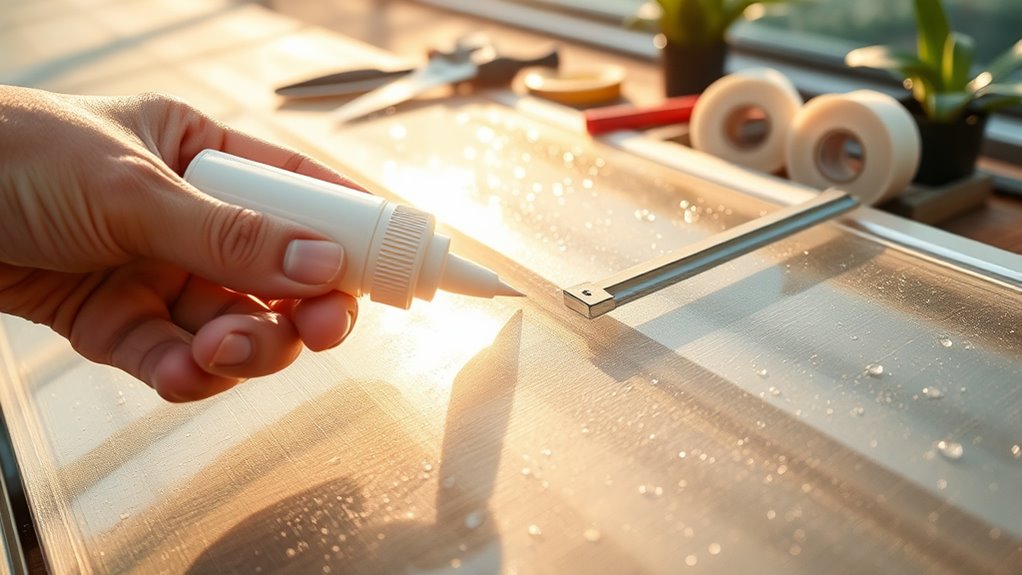
Before waterproofing your greenhouse panels, it’s essential to prepare them properly to guarantee a secure and effective seal.
Start by inspecting the frame to confirm it’s sturdy and free from rust. Next, clean the surfaces where the sealant will be applied, removing any dirt or debris.
Inspect the frame for stability and cleanliness, ensuring surfaces are free from dirt before applying sealant.
Choose UV-resistant sealants like silicone or polyurethane, and measure your panels accurately to fit your greenhouse dimensions. Gather all necessary tools and materials for the installation.
- Inspect the frame for structural integrity.
- Clean surfaces thoroughly.
- Select the right sealants for durability.
- Measure panels precisely for a perfect fit.
Taking these steps will help you create a reliable waterproof barrier, confirming your greenhouse remains protected from moisture.
Installing Effective Water Diversion Systems

To effectively manage water in your greenhouse, installing a well-designed water diversion system is essential.
Start by adding vinyl gutters, which are affordable and easy to install. Make sure your gutter system has a minimum slope of 1/16th inch per foot for ideal water flow. Backyard greenhouses can greatly benefit from a proper water management system to enhance plant growth and sustainability. Additionally, utilizing solar energy solutions can provide power for automated irrigation systems to ensure consistent moisture levels. Implementing efficient water systems can also optimize the use of available resources in your greenhouse. Keeping your greenhouse organized with efficient storage strategies can also help maintain a productive environment.
Don’t forget to connect downspouts to larger pipes, and include cleanout points every 100 feet to prevent clogs.
Implement roof washers to divert the first flush of rainwater, removing debris like leaves.
Choose tanks, either fiberglass or polyethylene, for rainwater storage, and verify they’re FDA-approved for water quality.
Regular maintenance will keep your system working efficiently, allowing you to make the most of your water resources in the greenhouse. Additionally, incorporating composting techniques can help you utilize rainwater effectively by enhancing soil health and retaining moisture.
Benefits of Proper Waterproofing
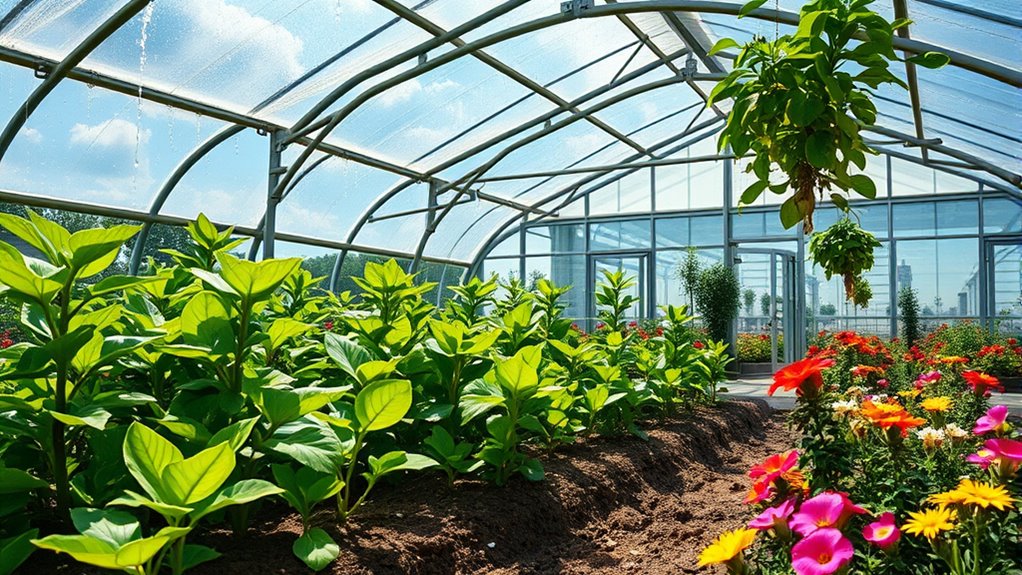
Proper waterproofing brings numerous benefits that can greatly enhance your greenhouse experience.
By ensuring your greenhouse is properly sealed, you help create an ideal environment for your plants while protecting your investment.
Properly sealing your greenhouse is essential for nurturing plants and safeguarding your valuable investment.
Here are some key advantages:
- Prevents Water Damage: Avoid structural issues and plant loss caused by leaks.
- Reduces Energy Consumption: Maintain a stable internal climate, lowering heating and cooling needs.
- Enhances Plant Health: A dry environment minimizes mold and mildew, supporting healthier growth.
- Extends Material Lifespan: Protect materials from moisture, reducing replacement costs over time.
With these benefits, you’ll not only improve your greenhouse’s efficiency but also foster a thriving environment for your plants.
Maintenance and Inspection for Long-Term Effectiveness
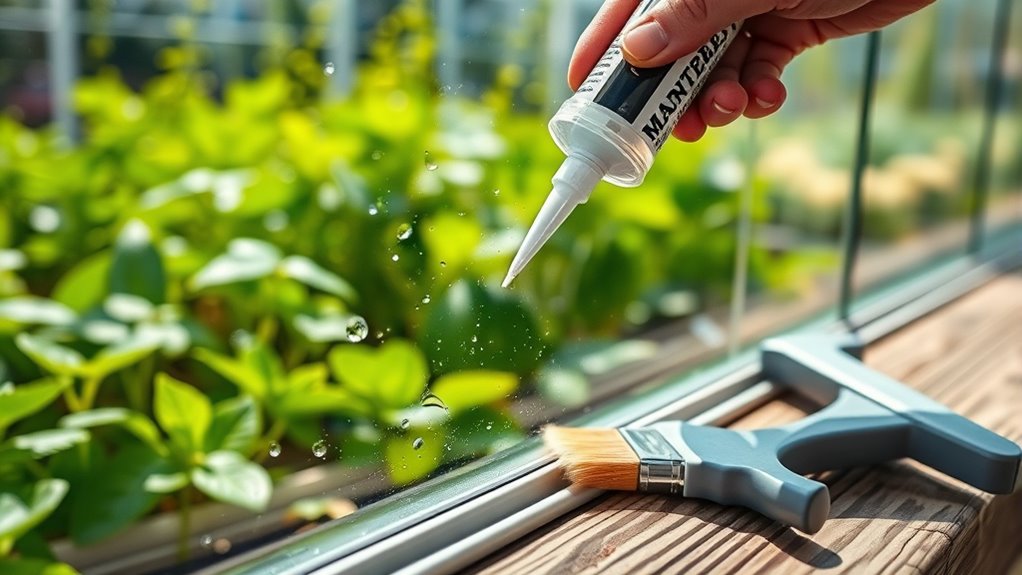
To keep your greenhouse waterproof, don’t overlook the importance of regular seal checks.
Timely damage repairs can prevent small issues from escalating into costly problems.
Regular Seal Checks
While maintaining the integrity of your greenhouse, regular seal checks are essential for preventing air and water leaks.
By routinely inspecting seals, you can guarantee a healthy environment for your plants. Here are some key points to remember during your checks:
- Inspect for Gaps: Look around roof vents and joints to catch any potential leaks.
- Clean Surfaces: Properly clean areas before applying sealants for better adhesion.
- Check Weather Conditions: Seal on dry, mild days for ideal curing.
- Use Appropriate Sealants: Choose sealants that match your greenhouse materials, like UV-stable foam tape for polycarbonate.
Regular seal checks help maintain your greenhouse’s effectiveness and longevity, guaranteeing your plants thrive in a stable environment.
Timely Damage Repairs
Inspecting your greenhouse for damage is crucial, especially since even small cracks or gaps can lead to significant water leaks and structural issues.
Check glazing materials regularly, and replace any damaged panels immediately to maintain integrity. Don’t forget to inspect the frame—repair any damage to prevent further deterioration. Apply protective coatings to metal parts to guard against rust.
Additionally, keep an eye on your drainage systems; clean gutters and downspouts to avoid blockages, and make sure they’re directing water away effectively.
After any severe weather, conduct thorough inspections to assess any new damage. By addressing these issues promptly, you’ll safeguard your greenhouse and guarantee ideal growing conditions for your plants.
Frequently Asked Questions
What Materials Are Best for Greenhouse Waterproofing?
When you’re looking for the best materials for greenhouse waterproofing, consider using Gorilla Waterproof Tape to seal any tears, and silicone caulking for smaller gaps around vents.
Heavy-duty zip ties offer extra security, while Thompson’s Waterproofing Clear Wood Sealer protects wood structures.
Don’t forget about UV-rated plastic for lining interior studs and weatherproof coatings for exterior surfaces.
These materials will help keep your greenhouse dry and efficient.
How Often Should I Reseal My Greenhouse?
You should reseal your greenhouse regularly, ideally at the start of each season.
After harsh weather, check for any gaps or leaks, as these can compromise your seals.
Depending on the sealant type, you may need to reapply every few years.
Conduct visual inspections to spot wear and tear, and incorporate resealing into your annual maintenance schedule to keep everything weather-tight and functioning efficiently.
Don’t wait for issues to arise!
Can I Waterproof an Existing Greenhouse?
Yes, you can waterproof an existing greenhouse!
Start by inspecting for gaps and potential leaks, then clean the surfaces thoroughly.
Use a high-quality silicone sealant for any joints and corners.
Don’t forget to apply Gorilla Tape on polycarbonate panels for added protection.
Regularly check and maintain your seals, addressing any issues promptly.
With the right techniques and materials, you’ll successfully enhance your greenhouse’s waterproofing and protect your plants.
What Are Common Signs of Water Damage in Greenhouses?
If you’re wondering about common signs of water damage in your greenhouse, look for visible leaks, structural issues like cracks, and mold or mildew growth.
You might also notice discoloration on walls or ceilings, indicating water seepage.
Listen for unusual sounds, like dripping or hissing, which could signal hidden leaks.
Addressing these signs promptly can help you maintain a healthy environment for your plants and avoid costly repairs down the line.
How Does Temperature Affect Waterproofing Materials?
Imagine painting a masterpiece, but the canvas is too hot or cold.
Temperature’s like a conductor, orchestrating how waterproofing materials perform. If it’s too chilly, those materials might just sit there, refusing to dry. Conversely, if it’s sweltering, they could crack like a dry lake bed.
You need to apply thin coats, allowing them to breathe and cure properly, ensuring your waterproofing stands strong against nature’s whims.
Keep an eye on those temperatures!
Conclusion
By mastering waterproofing techniques, you’re not just shielding your greenhouse; you’re creating a sanctuary where plants thrive like stars in a night sky. With the right sealants and effective diversion systems, you’re laying a solid foundation for growth and liveliness. Remember, regular maintenance is your guardian against the elements, ensuring your green haven flourishes season after season. Embrace these practices, and watch your greenhouse transform into a thriving oasis, resilient against the storm.
